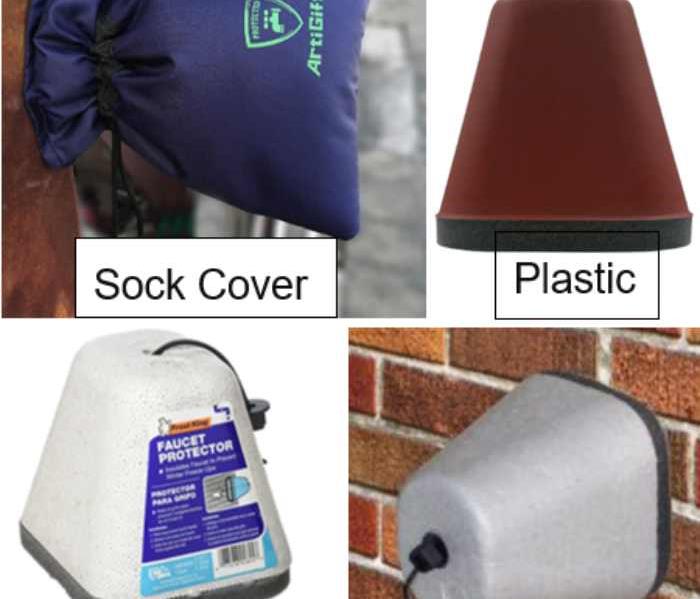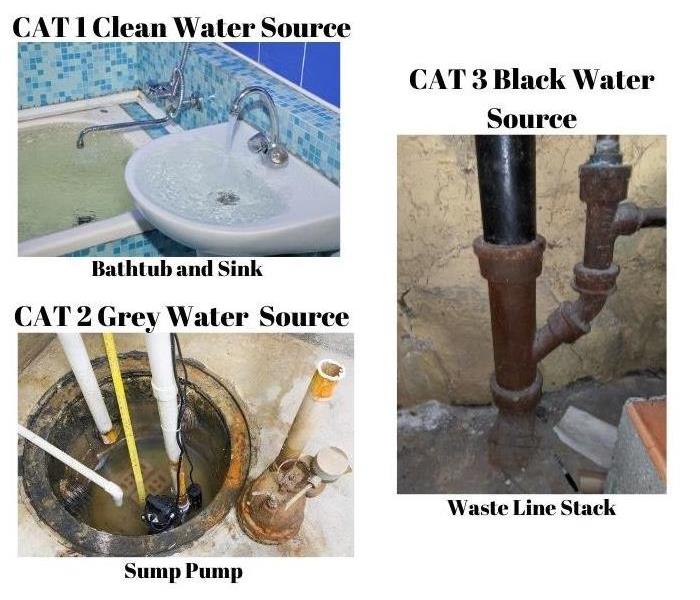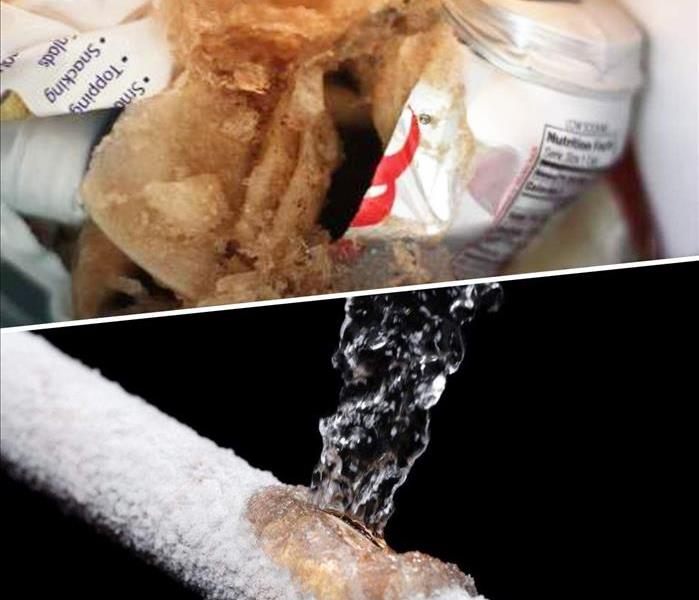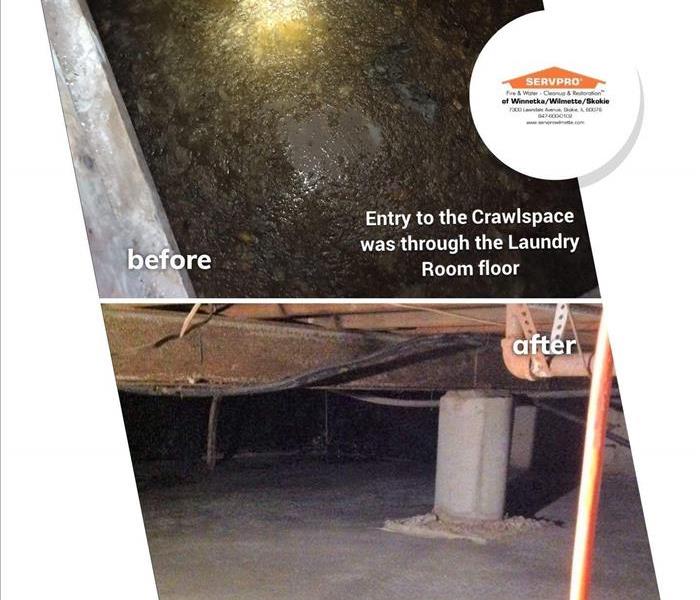Recent Water Damage Posts
STOP YOUR SPIGOT (OUTDOOR FAUCET) FROM FREEZING
12/27/2021 (Permalink)
 This photo shows various types of covers for your spigot (outdoor faucet).
This photo shows various types of covers for your spigot (outdoor faucet).
Freezing water in pipes can create costly damage. Spigots (outdoor faucets) in particular are prone to this kind of damage. It helps to prepare your spigots for winter before freezing temperatures arrive. You can do this by taking a few easy steps before winter arrives.
Close the Outdoor Supply Valve
Many outdoor spigot(s) have an indoor safety valve that allows you to drain the water from the outdoor section of the pipe, reducing the chance of the pipe bursting when trapped water freezes. Shutting off the water to your outdoor pipe is also handy if you need to replace the spigot or outdoor section of the pipe. You only have to turn off the safety valve for that fixture instead of shutting off water to the entire house.
- Find the pipe inside your house that leads to your outside spigot(s). This may be in your basement, garage, or crawl space.
- Shut off the water supply to your outside spigot(s). Look along the length of the pipe for the safety shut-off valve. Most valves are either round, metal knobs or straight handles that are 3 to 4 inches long. In some older homes, the shut-off valve may be a square post (no handle/knob) at the top of a pipe junction. You can use clamp vise-grips or pliers onto the square post and turn it clockwise until it stops.
Remove Attached Hoses and Empty the Outdoor Pipe
- Go outside and remove any hoses that may be attached to the outdoor spigot(s). Empty them of any remaining water, and store them in a safe place such as your garage.
- Turn on the exterior spigot(s) until the water stops flowing. This releases water trapped in the pipe, which reduces the chance of the pipe(s) freezing and allows you to safely replace or make any repairs to the existing spigot(s), if necessary.
Cover Pipe with Insulation
To protect your outdoor spigot(s) and pipes from sub-zero temperatures, you need to insulate them. Cover the spigot(s) and exposed pipe with the insulation of your choice.
- There are various options for insulating your pipes. They include fiberglass and foam insulation sleeves that are made to fit around piping. There are also heating tapes on the market that you can wrap around any size.
- For the spigot(s), there are outdoor spigot covers. These are generally made of foam, plastic, or insulated outdoor sock covers.
You can find most of these products in home improvement centers.
Tip: Any pipes running through unheated places such as basements and attics must also be insulated.
Tip: If you have underground sprinklers, make sure to drain them out as well by following manufacturer recommendations.
HERE COMES THE COLD!
12/25/2021 (Permalink)
Winter is coming upon us. Unfortunately, so will ice dams on our roofs.
Listed below are a few inexpensive solutions you can do yourself.
How to help get rid of ice dams
Once you have ice dams on your roof, your goal should be to eliminate them as quickly as possible to prevent any further damage to the exterior and interior of the house.
1 – ICE MELT SOCKS
1) A few pairs of nylon stockings.
2) A bucket (bag) of Calcium Chloride ice melt.
3) Scissors.
Cut the “leg” part off the stockings, and fill them up with 2-3 pounds of ice melt and tie the ends. That’s it.
Next, go up on the roof, and put ice melt socks vertically, one end onto the gutter and the other end up the roof slopes, spacing them every 3 feet. BE VERY CAREFUL WHEN DOING THIS! The socks will create a melt channel in the ice to allow the water to run off your roof. You can also place the socks into the gutters to prevent ice build-up there.
2 – SNOW RAKE
With a snow rake. You can remove snow off your roof before it melts and freezes along the eaves will minimize the effect of ice dams. Try to get rid of as much snow as you can without causing any damage to shingles.
This snow rake has two rollers on the bottom edge as well as a plastic sheet to help snow slide off the roof fast. The plastic sheet helps prevent damage to the shingles.
The rake is sturdy solid aluminum and lightweight. This makes it easy to use by most people.
3 – ICE MELT PUCKS
This product is the same as ice melting socks above. It is made from Calcium Chloride and is sold online, or at home improvement stores.
These, however, are not very effective. They do not work as well as the “sock” and can easily be blown off the roof. Unlike the sock, they just melt the ice around themselves and do not create a path for water to flow down the roof. You will need to use many pucks to get the desired effect.
Only you can decide if ice melt socks, pucks, and/or a roof rake are a good way to deal with ice dams.
If you’d rather not use them, some alternatives worth considering include:
These will require professional installation.
- Ice melting heat cables.
- Extra insulation in your attic to help prevent heat from escaping through the roof and causing ice dams in the first place.
- Ice metal panels that can better shed ice and snow from roofs.
Water Damage Categories – What do they mean?
12/22/2020 (Permalink)
 This picture shows three- (3) sources of water damage. CAT 1 - Bathtub and Sink, CAT 2 - Sump Pump, and CAT 3 - Waste Line Stack.
This picture shows three- (3) sources of water damage. CAT 1 - Bathtub and Sink, CAT 2 - Sump Pump, and CAT 3 - Waste Line Stack.
Water damage comes from various sources. From pipes and toilets to sewer backups. According to IICRC standards, there are three- (3) types of water categories: Category 1, Category 2, and Category 3.
Category 1 is considered "Clean Water". This category is from a source that poses no substantial harm to people. As examples, these sources could be from an overflowed bathtub and/or sink a broken water supply line to your refrigerators’ ice maker, or a leaking dishwasher water supply line.
- After 48 hours, a Category 1 can become a Category 2.
Category 2 also known as "Grey Water" poses health risks due to significant levels of contamination of bacteria, mold, and/or chemicals. This includes dirty water from washing machines, as well as leaks from water beds, broken aquariums, and sump pumps.
- Due to rampant bacterial breeding and mold growth, Category 2 becomes a Category 3 situation if left untreated for 2 days or more.
Category 3 is considered "Black Water". Black Water contains disease-causing organisms, toxins, and is grossly unsanitary. It may also contain 100s of bacteria and virus types, including HIV. Typical black water conditions occur from a sewer backup, a broken waste line stack, and rising floodwaters. Tetanus and other serious diseases are likely to be present in rising floodwaters.
With any of these categories, it is best to contact your professionals at SERVPRO of Winnetka/Wilmette/Skokie 847.600.0102. We are always here to help and our goal is to make it "Like it never even happened!"
Winter is Coming and so are Frozen Pipes
12/16/2020 (Permalink)
 This photo shows what happens to a pop can that is left in the freezer, and a household pipe that is exposed to freezing temperatures too long.
This photo shows what happens to a pop can that is left in the freezer, and a household pipe that is exposed to freezing temperatures too long.
Have you ever left a can of pop in the freezer too long? If so, you have a good idea as to what happens when your pipes freeze.
Typically, your home's pipes begin to freeze when the outside temperature is at least 20° F, and the pipes are exposed to that temperature for a prolonged period of time. Once the water freezes, it expands in volume. If this is allowed to go on for too long, the pipe will burst.
When a water pipe bursts, water will come pouring out and will not stop until the water is shut off at the water main. This should be down as quickly as possible. Be mindful of any nearby electronics or electrical wiring that may have gotten wet and be sure to steer clear of them. It is suggested that you attach a tag to your water main so you can always find it in an emergency.
Once the water has been shut off, call a plumber to have it repaired. And contact SERVPRO of Winnetka/Wilmette/Skokie at 847-600-0102 to start the clean-up and drying process. Time is of the essence. The longer the water sits, the more damage will occur to your walls, ceilings, floors, and contents. We at SERVPRO of Winnetka/Wilmette/Skokie are here to make it "Like it never even happened."
Got Sewage?
12/11/2020 (Permalink)
 This photo a before/after of sewage in a crawlspace. The Entry is through the Laundry Room floor. The sewage is to the top of the entrance.
This photo a before/after of sewage in a crawlspace. The Entry is through the Laundry Room floor. The sewage is to the top of the entrance.
Sewage backing up into a home, office, or business, can happen to anyone at any time. Many things can cause a sewage backup, from a pipe clogging, broken drain stack to a flood overfilling a local sewer system. Sewage can be hazardous to your health and can cause extensive structural damage to both your property and your plumbing system. Sewage can be a mixture of waste from both household and industrial sources. The waste can contain anything as harmless as soap to more harmful things such as human or industrial waste.
A sewage loss can seem like a relatively easy cleanup to tackle alone, but it should not be handled by anyone other than specialists. Due to the dangers and health risks of cleaning up a sewage loss, it is a much safer choice to leave the cleanup and restoration to the professionals. Sewage can release toxins or even infected dust, the risk of breathing in the toxins is very high. Once inhaled, the toxins can attack your upper respiratory system, causing asthma-like symptoms and shortness of breath. These fumes are often released into the air during the cleaning process, which is why it is especially important to hire specialists. Our highly-trained water/sewage damage restoration technicians will inspect your property to determine the extent of the damage. SERVPRO of Winnetka/Wilmette/Skokie trained technicians will create customized solutions to remove the sewage, damaged materials, such as baseboards and drywall, clean, and disinfect.
Do you need sewage cleaning services? Call SERVPRO of Winnetka/Wilmette/Skokie at 847-600-0102. We provide fast, effective sewage cleanup services to get your property dry, sanitary, and looking, and smelling, fresh once again. We work to make your home or office safe again.
Sources: Antoinette Ryan

 24/7 Emergency Service
24/7 Emergency Service



